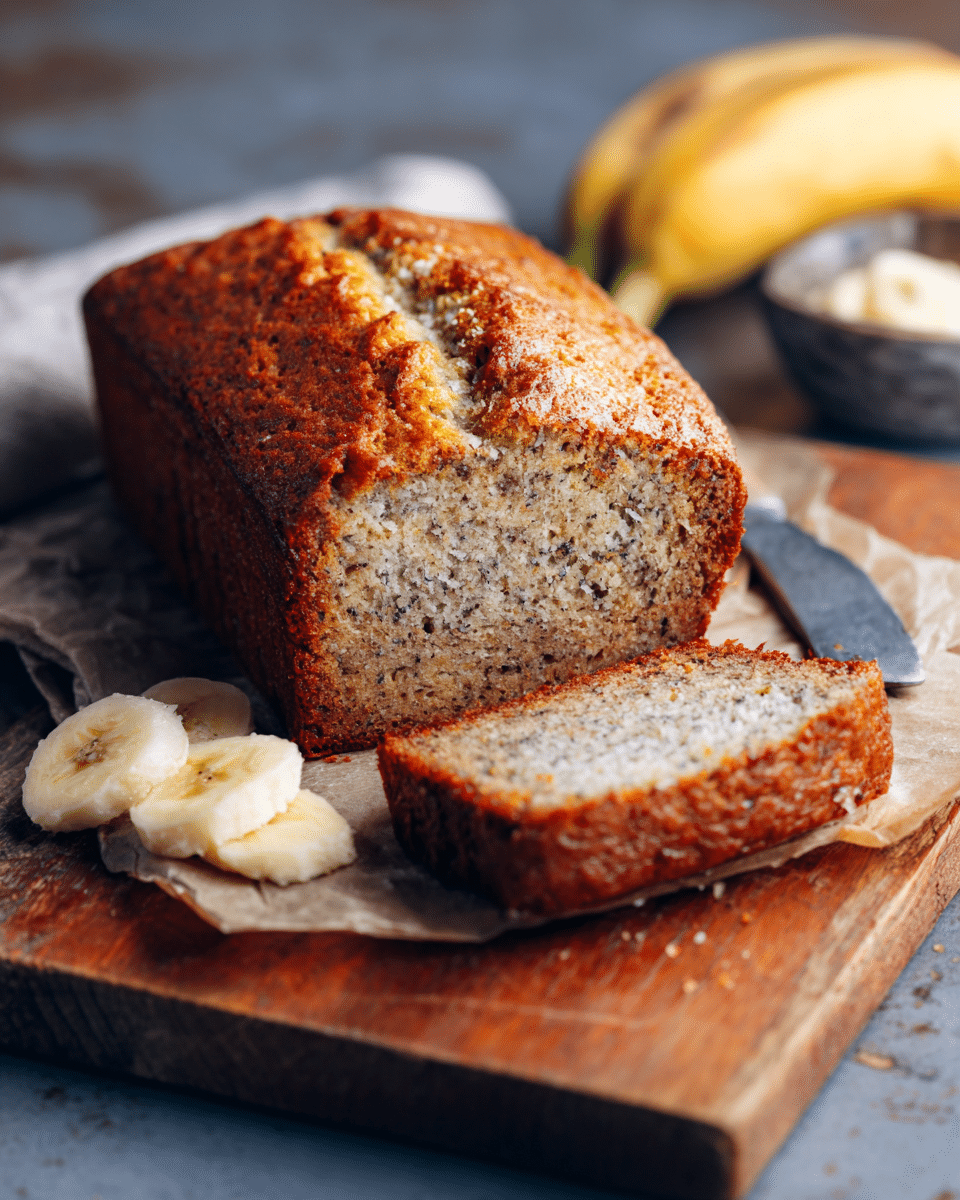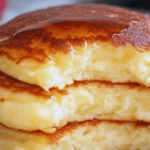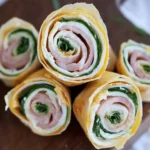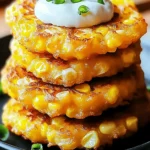Few things in baking are as comforting as the warm, sweet scent of banana bread fresh from the oven. With its golden-brown crust and tender, moist crumb, this loaf brings together the simple pleasures of ripe bananas, creamy butter, and a touch of sweetness in each bite. Whether you enjoy it plain, toasted with butter, or dressed up with nuts and chocolate chips, it’s a treat that never goes out of style.
This recipe celebrates the timeless charm of banana bread easy enough for beginners yet satisfying for seasoned bakers. The beauty lies in its adaptability: you can keep it classic or play with flavors by adding cinnamon, coconut, or even a drizzle of caramel. Perfect for breakfast, brunch, or dessert, banana bread is the ultimate comfort bake to share with family, friends, or enjoy quietly with your favorite cup of tea or coffee.
Full Recipe:
Ingredients:
-
3 ripe bananas, mashed
-
1/2 cup unsalted butter, melted
-
3/4 cup granulated sugar
-
1 large egg
-
1 teaspoon vanilla extract
-
1 1/2 cups all-purpose flour
-
1 teaspoon baking soda
-
1/4 teaspoon salt
-
1/2 teaspoon cinnamon (optional)
-
1/2 cup chopped walnuts or chocolate chips (optional)
Directions:
-
Preheat oven to 350°F (175°C). Grease a 9×5-inch loaf pan or line with parchment paper.
-
Mash bananas in a large bowl until smooth. Stir in melted butter.
-
Add sugar, egg, and vanilla; mix until well combined.
-
In another bowl, whisk together flour, baking soda, salt, and cinnamon.
-
Gently fold dry ingredients into banana mixture until just combined.
-
Stir in nuts or chocolate chips if using.
-
Pour batter into the loaf pan, smoothing the top.
-
Bake for 50–60 minutes, or until a toothpick inserted in the center comes out clean.
-
Cool in pan for 10 minutes before transferring to a wire rack to cool completely.
Prep Time: 10 minutes | Cooking Time: 55 minutes | Total Time: 1 hour 5 minutes
Kcal: 210 kcal | Servings: 10 slices
The Comfort and Legacy of Banana Bread
Few baked goods can match the universal appeal of banana bread. It’s not just a loaf it’s a warm hug in edible form. This golden-brown quick bread, known for its moist, tender crumb and rich banana flavor, has earned a place in kitchens across the globe. The version we’re exploring today is based on a timeless recipe from Nyra Recipes, a rendition that stays true to the traditional roots while leaving room for customization.
Banana bread is a remarkable blend of simplicity and satisfaction. It doesn’t require yeast, hours of proofing, or complex baking techniques. Instead, it thrives on pantry staples, ripe bananas, and a few minutes of prep work. The result is a loaf that can be enjoyed in countless ways from a morning breakfast companion to an afternoon snack or even a dinner dessert.
Why Banana Bread Continues to Reign Supreme
The enduring popularity of banana bread comes down to three main factors: taste, texture, and nostalgia.
-
Taste: The sweetness of ripe bananas infuses the entire loaf with natural flavor, often enhanced by subtle notes of vanilla or cinnamon. Optional add-ins like walnuts bring earthy richness, while chocolate chips add a decadent twist.
-
Texture: The loaf’s crumb is soft yet sturdy, making it easy to slice and perfect for toasting. The crust develops a light golden color, sometimes with an irresistible crackled top that hints at the softness within.
-
Nostalgia: For many, banana bread is tied to family traditions. It’s a recipe that parents and grandparents pass down, often without precise measurements just the shared knowledge of “how it should look” and “how it should smell.”
This combination of sensory pleasure and emotional connection has kept banana bread relevant for generations.
A Brief History of Banana Bread
While bananas have been cultivated for thousands of years, banana bread in its modern form didn’t appear until the early 20th century. Its rise to fame began during the Great Depression of the 1930s, when households needed to stretch ingredients and minimize waste. Overripe bananas too soft for fresh eating became an asset rather than a liability. Cookbooks and homemaking magazines began publishing recipes for banana-based quick breads, which used newly popular chemical leaveners like baking soda and baking powder instead of yeast.
By the 1960s and 70s, banana bread had solidified its place in community cookbooks, becoming a symbol of comfort and resourcefulness. It surged in popularity again in the 2020s, particularly during pandemic lockdowns, when baking became a source of stress relief and creative expression. Social media feeds filled with banana bread loaves, each slightly different yet unmistakably familiar.
The Science Behind Its Moist Perfection
One of banana bread’s most beloved qualities is its moist, tender crumb. This comes from a perfect balance of fat, sugar, and liquid combined with the natural moisture of bananas. Overripe bananas not only offer sweetness but also break down into a silky puree that evenly disperses through the batter.
The small amount of mixing required for quick breads prevents gluten from developing too much, ensuring the loaf stays soft rather than chewy. Baking soda helps the batter rise, reacting with the natural acidity of the bananas to create lift without yeast.
Optional mix-ins like nuts, chocolate chips, or shredded coconut not only add flavor and texture but also subtly influence the loaf’s structure. Nuts provide crunch, chocolate melts into pockets of richness, and coconut adds a hint of chew.
Adaptability for Every Kitchen
Part of what makes banana bread so enduring is its ability to adapt to different needs and preferences.
-
Healthier Swaps: Whole wheat flour can replace part of the all-purpose flour for extra fiber, and natural sweeteners like honey or maple syrup can stand in for refined sugar.
-
Dietary Adjustments: For vegan versions, plant-based butter and flax eggs work beautifully. Gluten-free flours can be used for those avoiding wheat.
-
Flavor Experiments: Cinnamon, nutmeg, and cardamom can add warmth, while citrus zest offers brightness. A swirl of peanut butter or Nutella creates a richer loaf.
This versatility means one base recipe can inspire dozens of variations, keeping it fresh for bakers who love to experiment.
Serving Suggestions Beyond the Loaf Pan
While banana bread is delightful on its own, it also shines as part of creative presentations:
-
Breakfast Boost: Toast a slice and spread with butter, almond butter, or cream cheese.
-
Dessert Plate: Serve with a scoop of vanilla ice cream and a drizzle of caramel or chocolate sauce.
-
Layered Treat: Use slices as layers in a trifle with whipped cream and fruit.
-
Portable Snack: Cut into thick slices, wrap individually, and keep on hand for quick energy.
Its mild sweetness makes it suitable for pairing with coffee, tea, or even a glass of milk. And because banana bread freezes well, it’s a practical make-ahead option.
Banana Bread Across the Globe
While the Nyra Recipes version reflects a classic Western approach, banana-based baked goods appear worldwide. In the Caribbean, you might find banana bread spiced with cinnamon, nutmeg, and sometimes rum. In the Philippines, banana cake is popular in bakeries, often topped with buttercream. In India, ripe bananas go into fritters or steamed cakes. Each culture adapts the banana to local tastes, but the comfort factor remains universal.
Why It’s the Perfect Beginner’s Bake
Banana bread is often the first baked good many people learn to make. It’s forgiving, meaning small mistakes like slightly overmixing or misjudging bake time by a few minutes rarely ruin the loaf. The process teaches essential baking skills: measuring dry and wet ingredients separately, gently combining them, and testing for doneness with a toothpick.
Even for experienced bakers, banana bread holds appeal because it delivers consistent results and allows for creative flair without complicated techniques.
Tips for Exceptional Results
While the Nyra Recipes method already yields excellent banana bread, a few extra considerations can take it from great to exceptional:
-
Choose the right bananas: The darker and spottier, the better. This ensures maximum sweetness and moisture.
-
Don’t overmix: Stir until the dry and wet ingredients are just combined to avoid a dense loaf.
-
Test early: Begin checking for doneness a few minutes before the recommended bake time; ovens vary.
-
Cool before slicing: Patience pays off cooling allows the crumb to set and flavors to deepen.
-
Store smartly: Wrap in plastic wrap or foil to keep moisture in, or freeze slices individually for quick defrosting.
The Emotional Side of Banana Bread
Beyond its flavor and ease of preparation, banana bread carries an emotional weight. It’s often baked in moments when we need comfort during rainy afternoons, holidays, or difficult seasons. The act of mashing bananas, stirring batter, and smelling the loaf as it bakes is deeply soothing. For many, it’s a taste of home, a reminder of being cared for, or a way to show care for others.
It also makes a thoughtful gift. Wrapped in parchment and tied with string, a homemade loaf says “I thought of you” in a way store-bought sweets rarely can.
Conclusion:
The Nyra Recipes banana bread is more than a way to use overripe bananas it’s a baking tradition that connects generations, cultures, and moments in time. Its adaptability ensures it remains relevant, whether baked in a humble home kitchen or a professional bakery. It’s as suitable for weekday breakfasts as it is for holiday tables, and as welcome in a lunchbox as it is on a dessert tray.
In a world of complex culinary trends, banana bread stands out for its simplicity, reliability, and heartwarming appeal. It asks for little and gives much: a fragrant kitchen, a satisfying slice, and a reminder that the best recipes often come from the humblest ingredients. Whether you keep it classic or dress it up with personal touches, one thing is certain banana bread will continue to hold its place as a true comfort classic.






